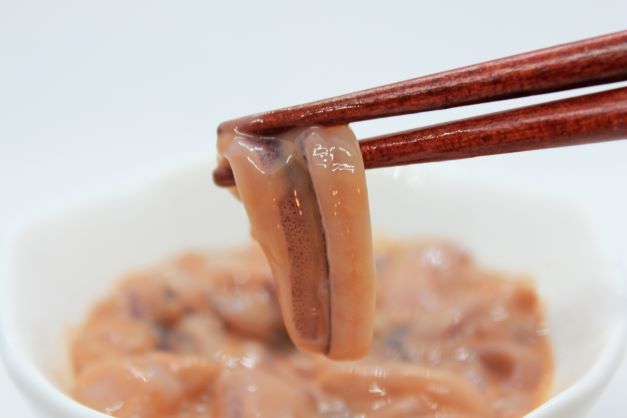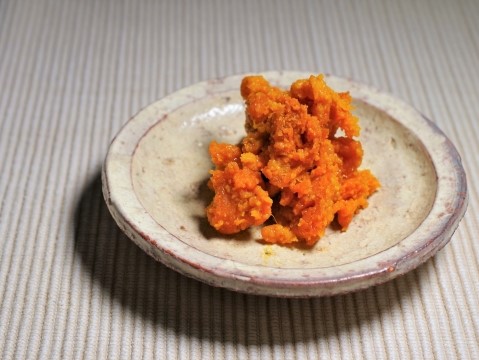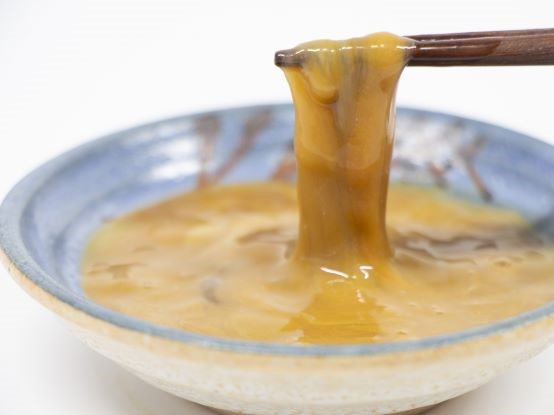
Generally, Shiokara (salted fish guts) is a food product made by maturing salted seafood meat and offal. This maturing is a chemical process in which proteins are converted into free amino acids by the digestive action of proteolytic enzymes contained in the offal, creating a rich umami, while the high salt content prevents spoilage. As maturing progresses, the taste becomes less salty and mellower.
Today, shiokara is rarely found in any other food than seafood, but in the past, it was also made from animal meat. As evidence, shiokara made from rabbit and deer meat is mentioned in documents (倭名類聚鈔) dating from 905 to 967.
In the Edo period (1603-1867), eating animal flesh became anathema, and shiokara made from animal flesh gradually declined, leaving only shiokara made from fish and shellfish.
In the Edo period, shiokara was called nashimono (なし物) or natsushimono (なつし物) or nanshimo (なんし物) and included fish and shellfish such as Red seabream (Tai), Horse mackerel (Aji), Pacific cod (Tara), Ark shell (Akagai), Orient clam (Hamaguri), Abalone (Awabi), Prawn (Ebi), and Crab (Kani), as well as birds such as Lark and Quail.
It is said that the term shiokara, which is still used today, took root around the end of the Edo period, and literature from that time describes shiokara being sold as Katsuo, Ami, Ebi, Ika, and others.
These days, shiokara is considered more of a luxury food than a side dish, and many shiokara products cannot be stored without refrigeration because the salt content has been reduced to less than 10% due to low-salt preference. Also, some products are seen with the addition of mirin or rice malt to suppress the salty taste.
And what I must tell you is that there are various delicacies not only in Japan but also in other countries, some of which are characterized by their odd smell and strange appearance, but are also very flavorful.
One of the most typical examples is the shiokara introduced here. It can be said that it is the top 5 stinky food in Japan.
We are fairly sure that Shiokara isn’t the type of dish that will have you coming back for more. But rest assured, Japanese cuisine has so much more to offer.
Types of shiokara in Japan
Ika-no-shiokara (salted squid guts)
Generally, Japanese common squid (Surume-ika) is used, and it is the most in-demand shiokara.
The process is to mix squid liver, commonly called “goro,” with shredded squid meat in a ratio of 1:15 to 20, add 10 to 20% salt, and allow the mixture to stand for about half a month, stirring occasionally, until the meat is broken down by enzymes to produce the characteristic umami, which is then ready to eat. There are three types of shiokara: shiro (shiro means ‘white’)-zukuri, in which the skin is removed; aka (aka means ‘red’)-zukuri, in which the skin is left on; and kuro (kuro means ‘black’)-zukuri, in which squid ink is added.
Tsubu-uni (salted and preserved sea urchin)

Tsubu-uni is a specialty of Yamaguchi Prefecture and was invented around 1887, using Bafun uni, Aka uni, and Murasaki uni as ingredients.
The process begins by rinsing the gonads removed from the sea urchin. The product is then sprinkled with about 10% salt, packed in a bottle containing about 20% alcohol, shaken well, and aged for about half a month. The resulting product has a low salt content of about 8%, but can be stored at room temperature for about a year because of its alcohol content of about 9%.
Shuto (salted bonito guts)
Shuto (酒盗) is a shiokara made from bonito entrails. It is a specialty of Kochi Prefecture and is said to have been named by Yamauchi Toyosuke. Fatty bonito that has been frozen for a long time will become discolored, so bonito caught from spring to summer, when it has less fat, is the best material for shuto.
Among the removed internal organs, the pyloric appendage, stomach, and intestines are rinsed and aged with 30% salt. The one made with meat and offal is called “Tataki”, while the one made with only the stomach and intestines is called “Hantou (飯盗)”. It is also called Japanese anchovy and has a distinctive smell.
Konowata (salted sea cucumber guts)

Konowata is a shiokara, the digestive tract of sea cucumbers (海鼠).
When making dried or pickled sea cucumbers, the digestive tract is removed, washed, and soaked in 30% salt. The value of konowata is diminished when it is torn off and the yield is only about 1%, making konowata especially expensive among shiokara. The moment you put it in your mouth, you can smell the mellow aroma of the sea, and it is characterized by its unique sticky texture.
Mefun (salted salmon guts)
Mefun is a shiokara made from Salmon’s kidney.
The removed kidneys are washed in salt water, sprinkled with salt, hardened, then washed in thin salt water to reduce the salt content to about 12% and dried in the shade. The fish is then packed in containers and aged for about six months before being made into a product. The product has a maturing smell peculiar to salted fish.
Uruka (salted ayu guts)
Uruka is the shiokara of ayu fish entrails. There are ko-uruka made with ayu fish ovaries, shiro-uruka made with testes, kiri-uruka made with chopped meat mixed with the entrails, and shibu-uruka made with entrails other than ovaries and testes.
The process is the same for all ingredients: add about 30% salt, remove the leaching liquid, repeat the process of adding more salt, and let the product mature for about one year.
Sukugarasu (salted orange-spotted spinefoot)
In Okinawa, shiokara is called karasu. Kara means spicy and su means salt. Suku refers to the juvenile orange-spotted spinefoot, which are caught around the new moon of the sixth lunar month, when they gather in large schools on coral reefs.
The fish is matured in a dark place with 30% salt added to the fish. The fish is ready to eat within 2 to 3 days after being marinated, but the longer maturing fish is considered tastier. In Okinawa, shiokara of bonito entrails is called Watagarasu, shiokara of squid is called Ichagarasu, and shiokara of sea urchin is called Gashagarasu.
Ganzuke (salted fiddler crab)
A specialty of the Ariake Sea coast of Saga Prefecture, it is mainly made from fiddler crab and is said to have been invented around the 18th century by the lord of the Nabeshima feudal lord at that time.
The process involves removing the abdomen, mashing the fiddler crab with a mortar, adding about 30% salt, chili peppers, and other seasonings, and maturing the mixture for about three months.
Types of shiokara in Southeast Asia
Jeotgal (젓갈)
On the Korean peninsula, shiokara is called jeotgal or jeot, and there are over 40 varieties. Among them, 새우젓 made with small shrimp and 멸치젓 made with half mouth sardine are consumed in large quantities because they are essential for kimchi (김치) production.
鮭
The Fujian Han Chinese in Taiwan refer to the shiokara as 鮭 or 鹸鮭. Ingredients include shrimp, small fish, and crab.
Mắm
In Vietnam, shiokara, fish sauce, and narezushi are collectively called mắm, all of which are produced with the main purpose of flavoring dishes.
For example, mắm tôm, a shiokara paste of small shrimp, is made by adding about 20-30% salt to freshly caught shrimp, grinding them in a blender, and then spreading them on winnows and drying them in the sun for 2-3 days before maturing them in a container. It will be ready to eat in about a month, but those that have been around for more than a year are considered tasty.
[sc_apply url=”https://sushiuniversity.jp/apply/”]
We hope this information will be helpful.

Revision date: February 13, 2023
Share this article